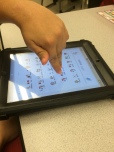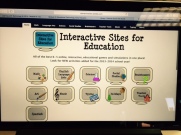EDU 6526 Video Analysis #2
5-7 Grade: Special Education Self-Contained Math Class
I am so grateful that a special education video was made available for this video analysis. I feel that the teacher did a fine job delivering the lesson. She was able to keep the pace as well as interact with the students. For the purpose of this video analysis I will be focusing on questioning, note taking, and summarizing. I will also briefly speak on a noticeable problem behavior and her behavior tracking method. I will be weighting my observations using Classroom Instruction That Works: Research-Based Strategies for Increasing Student Achievement (2nd ed.) by Dean et al and A Handbook for Classroom Instruction That Works (2nd ed.) by Pitler and Stone.
Questioning:
As Dean et al (2012) points out “effective cues and questions help students access their prior knowledge and put that knowledge to use learning new information” (Kindle Loc. 963). The questions that the teacher asked were simplistic but purposeful. In math the questions are usually going to be analytical in nature due to “exact” nature of mathematics. The questions were clear and precise and demanded that the students responded using their notes from past and present class sessions. The teacher also deployed clear cues as well. Pitler and Stone (2012) point out that cues and questions at the beginning of the lesson should focus on the important content to come (p. 97). The teacher did well to use these strategies to set the momentum. The video doesn’t cover the entire lesson but the set up using cues and questioning was done proficiently. Taking a look at the Teacher Rubric: Cues and Questions I would have to say the teacher would average a 4 because her questions were in fact well used and showed dedication to the content (Pitler and Stone, 2012, p. 106-108).
Note Taking and Summarizing:
There are many challenges in special education. One of the most prevalent is the ability to get the students to understand and retain information. Summarizing is “the process of distilling information down to is most salient points…” (Dean et al., 2012, Kindle Loc. 1346). The purpose is to facilitate understanding and memorization. Note taking helps with this process by putting the important points and big ideas in meaningful and relevant language in such a way to make it assessable to the students. As Dean et al (2012) states, “Summarizing and note taking help students deepen their understanding of information because these strategies involve higher-order thinking skills” (Kindle Loc.1346). The questions the teacher uses allowed her student to use summarizing skills. They were able to use notes to conceptualize the answers. The notes those students were using were accrete and complete. We know this because she used teacher-prepared notes. She modeled the notes and was instructed to write exactly what she wrote. This ensures that only the information they needed was put on paper. The teacher’s questions were directed around the new notes and prior notes. In a special education classroom it is almost (depending on the ability of the student) impossible to ask the students to summarize and note take on their own with any success at all. With that said, the teacher did a great job engaging the students in note taking and summarizing. They are learning the content and how to take notes. Perhaps later on the teacher will let them try to take their own notes. If she did this it would be beneficial to provide an opportunity for them to revise their notes and (by comparing and contrasting them with her example) use them during a review (Dean et al, 2012, Kindle Loc. 1546). Overall, I feel she did the best she could to employ both summarizing and note taking. According to the Teacher Rubric: Note Taking she would receive a 4 in the first category Give students teacher – prepared notes (Pitler and Stone, 2012, p. 198-200). In most special education classes this would be the most used method of note taking. These notes would also be beneficial when developing solutions stations. Solution stations can be placed on a wall in the class or in personal folders that can be used during assessments, assignments, and group or individual work. A great way to help the students to remember content.
Overall the teacher did a great job in the above areas. The last thing I’d like to point out was her ability to ignore the disruptive student (taping pencil continually). This is vital when dealing with problem behaviors in the classroom. His behavior function most likely was to: 1) disrupt the class, and/or 2) get attention. By ignoring this behavior and still rewarding the class for good behavior she is effectively preventing reinforcement for his behavior. I felt this was an ideal example of classroom management in the presence of a behavioral issue.
With such a brief clip it is hard to truly analyze this classroom experience. However, from what I saw she did a marvelous job. Special education is not for the week of mind or heart. Other things she did well were providing recognition, and feedback. Both of these are vital in any classroom. One of the things I would consider using in my classroom is the backwards counting as a launch button to learning. I offer many props to the teacher for a great example of a positive learning environment.
Dean, C., Hubbell, E., Pitler, H., & Stone, B. (2012). Classroom Instruction That Works: Research-Based Strategies for Increasing Student Achievement (2nd ed.). Alexandria, VA: ASCD, Denver, CO: MCREL Mid-continent Research for Education and Learning.
Pitler, H., & Stone, B. (2012). A Handbook for Classroom Instruction That Works (2nd ed.). Alexandria, VA: ASCD, Denver, CO: MCREL Mid-continent Research for Education and Learning.
5-7 Grade: Special Education Self-Contained Math Class
http://5-7 Grade: Special Education Self-Contained Math Class

